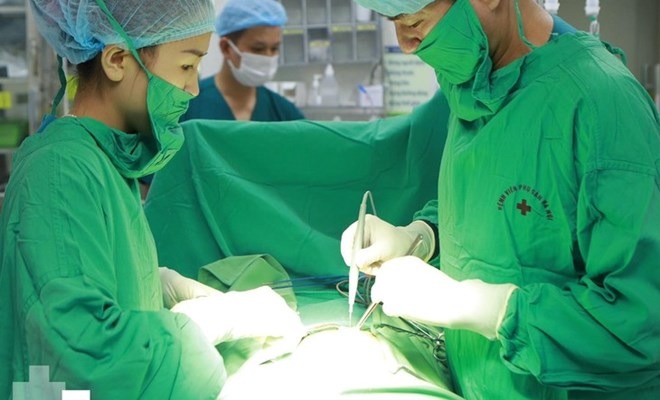Medical news June 23: Successful treatment of malignant tumors thanks to early detection
Only 15 years old, a 9th grade female student in Bac Ninh had a prolonged stomach ache and was shocked when the doctor suspected a giant malignant tumor.
Thought it was weight gain turned out to be malignant tumor
According to Hanoi Obstetrics Hospital, a 15-year-old female student from Bac Ninh was brought to the hospital with an abnormally large belly and abdominal pain.
 |
| Doctors at Hanoi Obstetrics Hospital during a surgery on a patient. |
The girl's mother said that this phenomenon happened a few months ago, but the whole family thought that the girl had gained weight because she was eating too much. The girl's belly was getting bigger and she was complaining of pain, but the family waited until she finished her 10th grade entrance exam before taking her to the Hanoi Obstetrics and Gynecology Hospital for a check-up.
Ultrasound images showed that the female student's right ovary had a tumor measuring nearly 24cm. Magnetic resonance imaging (MRI) recorded images of a multi-cystic, multi-lobular mass, doctors thought it was an ovarian teratoma, suspecting cancer.
The patient was referred to the Department of Gynecology and Surgery (A5) for open surgery and on-site cryotherapy. Associate Professor, Dr. Le Thi Anh Dao, Head of the Department of Gynecology and Surgery (A5) said that this was an immature teratoma (cancer). The large 24cm tumor was removed and taken out of the body.
The patient's tumor is germ cell, in the early stage, the chance of effective treatment is high. After surgery, the patient's health is relatively stable.
The most common type of ovarian cancer is epithelial ovarian cancer (accounting for 90% of ovarian cancers). Other rarer types include germ cell cancer and stromal cancer. Ovarian cancer in a 15-year-old child like the case above is considered rare.
Each year, Vietnam has about 1,200 cases diagnosed with ovarian cancer.
This disease progresses silently, quietly, the symptoms are not obvious and are often ignored by women. If not treated promptly, cancer cells will invade surrounding tissues and organs, causing loss of the function of hormone production, egg cell production, and pregnancy of the ovaries.
In the severe stage, cancer cells metastasize through the blood or lymph to many other organs of the body and form new tumors.
According to doctors, the exact cause of ovarian cancer is still unknown.
But studies show a link between the following factors that increase the risk of ovarian cancer: Women who have gone through menopause or have had few children; irregular menstruation; women who use ovulation-stimulating drugs; and postmenopausal hormone replacement therapy - people with breast cancer.
Women whose mother or sister has had ovarian cancer, breast cancer, or colorectal cancer have a 2 to 4 times increased risk of developing ovarian cancer.
Doctors recommend that women should go to the hospital immediately when experiencing symptoms such as abdominal pain below the navel, bloating; frequent urination; and gradually enlarging abdomen.
Congenital defect causes baby girl to have unusual tumor
A small tumor under the left jaw of 12-year-old Ha appeared a year ago. Now it is painful to the touch and has a swollen neck. The doctor discovered a congenital branchial cyst.
The patient had a 3x4 cm gill cleft cyst in the left neck. This is a rare congenital malformation, accounting for about 1% of all gill cleft cyst malformations. They are formed due to abnormalities in embryonic development that prevent the gill cleft system from closing normally.
According to Dr. Nguyen Do Trong, Pediatric Surgery Specialist, Tam Anh General Hospital, Ho Chi Minh City, there are three types of gill cleft malformations including cysts, sinuses or fistulas. Cysts have an epithelial layer without an external opening so they are often asymptomatic.
The recognizable sign of an opercular cyst is a mass in the neck, located at 1/3 of the angle of the lower jaw and horizontal to the common carotid artery.
This is a congenital defect, but usually develops in adults, growing rapidly over about 1-3 weeks.
According to Dr. Do Trong, the rate of this malformation is equal in men and women. Most children with the malformation can live with it for their whole lives without needing intervention if the tumor does not increase in size or become infected.
However, the deformity causes loss of aesthetics, the tumor grows large and can become infected, creating an abscess. Some cases of complications due to the cyst leaking fluid and pus cannot be treated with medication and must be surgically removed.
In Ha's case, the tumor caused aesthetic loss and psychological effects, so the family decided to surgically remove it. The surgery was difficult because the branchial cyst structure was located near nerves and blood vessels. The patient was prone to many complications during the intervention, such as uncontrolled bleeding and nerve paralysis.
The doctor meticulously removed the entire tumor, preserving as much blood vessels and nerves as possible after one hour of surgery. The small incision, about 4 cm in size, healed quickly, and the baby was discharged the next day.
Cleft cysts can be misdiagnosed as goiter or cervical abscess. Doctors recommend that parents take their children to the doctor if they notice any unusual signs such as punctured skin on the neck, discharge, swelling or unusual lumps on the neck.
Source: https://baodautu.vn/tin-moi-y-te-ngay-236-dieu-tri-thanh-cong-u-ac-tinh-nho-phat-hien-som-d218324.html

























![[Photo] National Assembly Chairman Tran Thanh Man visits Vietnamese Heroic Mother Ta Thi Tran](https://vphoto.vietnam.vn/thumb/1200x675/vietnam/resource/IMAGE/2025/7/20/765c0bd057dd44ad83ab89fe0255b783)












































































Comment (0)